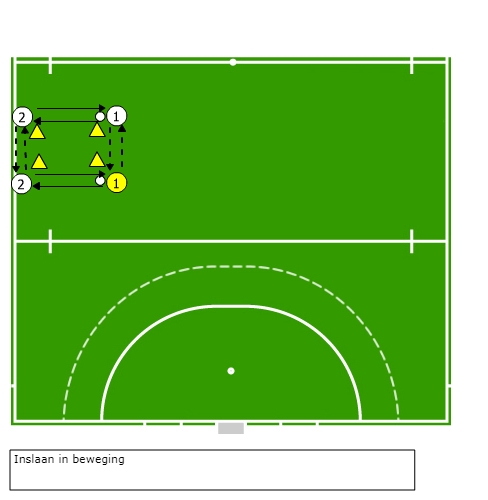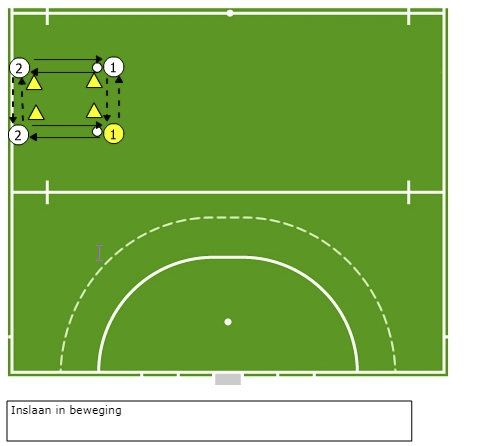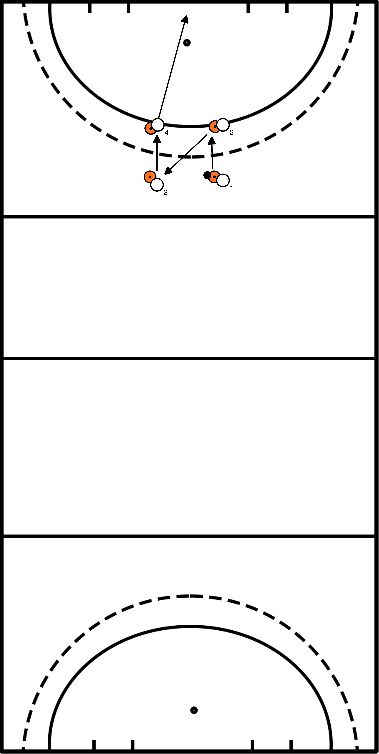Hockey drills for technique warming-up
- The children run through the room in pairs.
- One child tries to follow the other.
- Variation
- The child at the front has to suddenly change tempo.
- The child in front must always change direction sharply.
- Groups of four or five children.
- Groups of four or five children and when the signal is given, the one in the back sprints to the front and then leads the rest.
- There are all kinds of obstacles in the field, such as mats, hoops and pilons.
- The trainer leads the way along these obstacles, the children follow him.
- Variation
- The children run in pairs along these obstacles.
- They run backwards.
- They run while taking sideways steps.
Aim:
To become physically as well as technically warm as preparation for the training.
Set up:
The exercise will be done with a maximum of 4 people. Of course you can put a multiple of these so that the exercise still works.
1. The players 1 start with the ball and play it to their players 2. Then they change positions.
2. Players 2 play the ball back to players 1 and also change positions.

Variations:
- You can vary the way of passing (hitting, push, flats)
- Increase the distance between the pilons that players only has to run further.
- Increase the distance between the pilons that players have to pass over longer distances
- Increase both distances.
- Increase speed.
- Make as many successful passes as possible in time.
Points of attention:
- Sit low for a good control.
- Stick to the ground at ball control.
- Play the ball on the forehand side.
- Stand still while performing a ball control.
Aim:
Getting warm through a combination of passing, running and controlling the ball while running or standing still.
Set up:
This exercise also known in volleyball. The pilons are not quite in a triangle. It is possible, depending on the number of players, to set up multiples of the exercise.
1. The player at A plays the ball straight on to the player at B.
2. The player at B plays the ball to the player at C and runs towards point A.
3. The player at C receives the ball at point D and passes it to point A.
4. For the substitution A goes to B, B via D to C and C to A.

Variations:
- The stroke can be varied. (hitting, push, flats)
- The distances can be increased or decreased to adjust the level of difficulty.
- Pilons can be placed to play in between. This to increase the accuracy. When you make the pilons smaller, the difficulty increases.
- To play the ball from C to D, it can be bounced.
- To play the ball from D to A, it can be bounced.
- You can also place point C on the other side so that you turn backhand and forehand.
- When you place point C in 90 degrees from point B, you can rotate the same exercise only then from a different angle at point D.
- When you put down different situations, you can let the exercise rotate. Situation A is the standard, with situation B the exercise is mirrored, with situation C the exercise is set up in such a way that point B and C are at 90 degrees from each other and situation D is a mirror of situation C.
Points of attention:
- As a trainer you can take a good look at the different techniques of your players.
- Sit low when controlling the ball
- When playing the ball from C to D, the ball must not pass too far in the direction of A. The aim is for the player coming from B to take the ball at right angles.
- Play where possible on the forehand.
- Stand ready to control the ball. (low to the ground, stick on the ground)
Aim:
- To become physically as well as technically warm as preparation for the training.
Design:
- The exercise will be done with a maximum of 4 people.
- Of course you can put a multiple of these so that the exercise still works.
- The players 1 start with the ball and play it to their players 2. Then they change positions.
- Players 2 play the ball back to players 1 and also change positions.

Variations:
- You can vary the way of passing (hitting, push, flats)
- Increase the distance between the pilons so that one only has to walk further.
- Increase the distance between the pilons so that one only has to move on.
- Increase both distances.
- Increase speed
- Make as many successful passes as possible in time.
Points of attention:
- Sit low for good control.
- Stick to the ground at ball control.
- Play ball on the forehand side.
- Stand still at ball acceptance.
- Player A dribbles the ball to the next pilon and then plays the ball to player B.
- After playing the ball player A runs to player B's place.
- Player B does the same and plays the ball to player C.

Place 15 to 20 pilons over a distance of about 40 metres from the back line towards the middle line, in a straight line. The spacing between them at the basic form should be 2 meters.
Make 2 rows of players that are positioned behind the back line. The players do their exercise on both sides of the pilons at the same time towards the end of the series of pilons. There they turn and dribble with a wide curve back to the beginning. When the first two are at the fourth pilon, the next two can start.
Put players with an equal physical capacity next to each other. You can put players next to each other based on their positions (defender versus defender, attacker versus attacker).
Exercise
1. On the signal the front 2 players start.
2. Sprint 2 pilons forward and then 1 pylon backward.
3. Keep your face forward, so don't turn during the exercise.
4. The intensity is 90% of the player's maximum speed. Especially the forward runs (starting) have to be explosive and with short steps.
5. At the end of the series of pilons you turn with a wide bend and dribble back slowly to the starting point.
6. Repeat this exercise once.
Variations
1. Identical to the basic form, but now with the pilons in a different pattern: between the first 2 pilons is 1 meter, between the next pilons 2 meters, then 3 meters, 4 meters and finally 5 meters. After this you reduce distances again (respectively 4, 3, 2 and 1 meter space between the pilons). In total you will have 18 pilons.
2. Identical to the basic form, but now with a different pattern: between the first 3 pilons 1 meter, the next 2 pilons 5 meter, then again 3 pilons with 1 meter, 2 pilons with 5 meter. After this, place the same pattern again (4 times the same pattern in 1 line, with a total of 18 pilons).
3. Identical to variation 3, but now you don't place the pilons in a straight line, but in curves.
4. You make a straight line of pilons and arrange them as you see fit. Make sure there is a lot of variation.
5. Identical to variation 4, but now with curves.
Intensity of the exercise
The intensity is 90% of the maximum effort. Panting, should be present in the forward runs, because they are highly explosive. Good body control and athletic posture should be maintained, EMI 7/8.
- Player 1 plays the ball to Player 2,
- Player 2 plays the ball to Player 3,
- Player 1 has meanwhile run on to the position of Player 2 only to stand a bit deeper,
- Player 3 plays the ball to Player 1,
- Player 2 ran behind his ball and also went a little deeper,
- Player 1 plays the ball to Player 2,
- Repeat until you reach the goal.
- Player 1 plays the ball to player 2
- Player 2 plays the ball to player 3
- Player 3 plays the ball to player 4
- Player 4 finishes on target
- Everyone runs to where he passes and when you've shot at goal you start at Player 1's spot








